


✅ Eligibility Criteria
The Department of Computer Science, established in 1988, equips students with a strong foundation in programming, data structures, artificial intelligence, and cybersecurity. The program blends theory with practical applications, preparing graduates for careers in software development, IT services, and emerging technologies.
Programme Highlights
Career Opportunities
Graduates can pursue careers as Software Developers, Data Analysts, Cybersecurity Specialists, IT Consultants, Web Developers, Cloud Engineers, and AI Specialists. Many opt for higher education (M.Sc. CS, MCA, MBA IT) or certifications (AWS, Data Science, Ethical Hacking, Full-Stack Development) to enhance career prospects.
